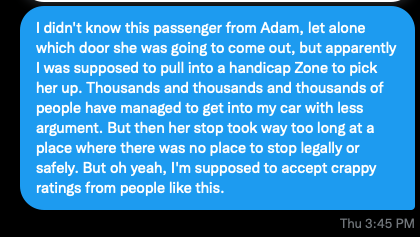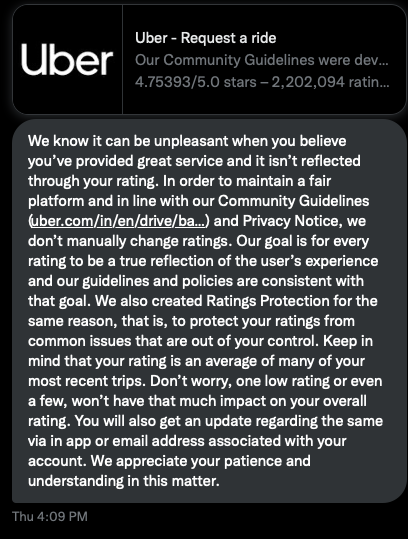This particular saga begins at a fast food restaurant in West Mifflin, a suburb of Pittsburgh. Uber has the pin for this on a particular side of the building, so that’s where I drove to and waited for my passenger. There are two doors on that side of the building.
Almost always, when I pick up at a fast food restaurant, I’m taking an employee home, and as it happens, this particular establishment has what appears to be a large workspace or office behind one of the doors, so there was absolutely no way I could rule that door out.
The other door has handicapped parking in front. I didn’t know how long I’d be waiting, so I parked across the way, in plain view of both doors, but absolutely not blocking disabled access, and out of the way of cars exiting the drive-thru. My passenger eventually came out, upset that I hadn’t pulled into the handicapped zone. She was not visibly disabled, I don’t have a disabled placard, and there is no special permission for Uber drivers to use handicapped spaces even for disabled passengers.
Understand, I have been driving for Uber and Lyft since 2016. Thousands upon thousands of passengers have managed to find my car and get in with less argument.
I was strongly tempted to throw her out and cancel the ride. And really, that’s what I should have done, because by taking her, she now has the opportunity to give me a bad rating.
The story isn’t over. This was a trip with a stop at a pawn shop on a busy street in Pittsburgh’s East Liberty neighborhood. The pawn shop has no safe or legal place to stop in front. She promised to be quick. She was not quick. She had to go to a nearby automated teller machine to get cash for the pawn shop. I had pulled onto the sidewalk to try to get out of the way traffic as much as possible, but these are narrow streets and I was still partially blocking traffic.
And so I complained to Uber (figure 1), via a Twitter direct message because the function for contacting Uber support through the app is damned hard to find:

Fig. 1. Screenshot taken December 18, 2022, of message sent to Uber on December 15 by author. A screenshot of the waybill was attached but includes personal information and so is elided here. It suffices to very specifically identify the trip and me as the driver.
They replied in effect that one bad rating wouldn’t have that much effect on my overall driver rating (figure 2).

Fig. 2. Screenshot taken December 18, 2022, by author of message sent to author by Uber on December 15.
In truth, however, I’m almost positive that the overall driver rating does affect how many rides you are offered. I strongly suspect that, other things being equal, Uber’s algorithm will offer the ride to a driver with a higher rating. If this is true, then yes, even one bad rating matters.
Uber did not mention even that they would ask this passenger to not expect drivers to do unsafe or illegal things. And so I replied (figure 3), noticing that how they treat passengers is very different from how they treat drivers:

Fig. 3. Screenshot taken December 15, 2022, of message sent to Uber on December 15 by author.
I was simply reacting to an obvious injustice. But I have been diagnosed with a post-traumatic disorder-related condition, so in fact, the threatening messages Uber sends me have an impact that recalls the beatings I received from my father, the bullying I suffered in primary and secondary school, abusive employers I’ve worked for, and, indeed, my entire experience of the job market since the dot-com crash.[1]
I’m realizing now that my complaint goes to the heart of Uber’s business model:
The company [Uber], [Uber’s top lawyer, Tony West] told reporters on Wednesday [September 11, 2013], “is serving as a technology platform for several different types of digital marketplaces.” (Uber also offers food and freight delivery, along with rental bicycles and scooters.) Thus, West said, the whole ride-hailing project would fall “outside the course of Uber’s usual business,” as the law [California Assembly Bill 5] stipulates.[2]
If indeed Uber is merely “a technology platform for several different types of digital marketplaces,” then it ought to be neutral in disputes between passengers and drivers. It manifestly is not, and in so doing, looks much more like an employer—and an abusive one at that—creating, as I observed, a “hostile work environment” for drivers.
I am not a lawyer. But I’m not seeing how to reconcile the “technology platform” defense with its very unequal treatment of drivers.
- [1]David Benfell, “About my job hunt,” Not Housebroken, n.d., https://disunitedstates.org/about-my-job-hunt/↩
- [2]Noam Cohen, “How Tech Firms Like Uber Hide Behind the ‘Platform Defense,’” Wired, September 13, 2019, https://www.wired.com/story/how-tech-firms-like-uber-hide-behind-the-platform-defense/↩
Pingback: The double standard in how Uber handles complaints - Irregular Bullshit
Pingback: An abortion ban by other means in Pennsylvania? - Irregular Bullshit
Pingback: A life worth living - Not Housebroken